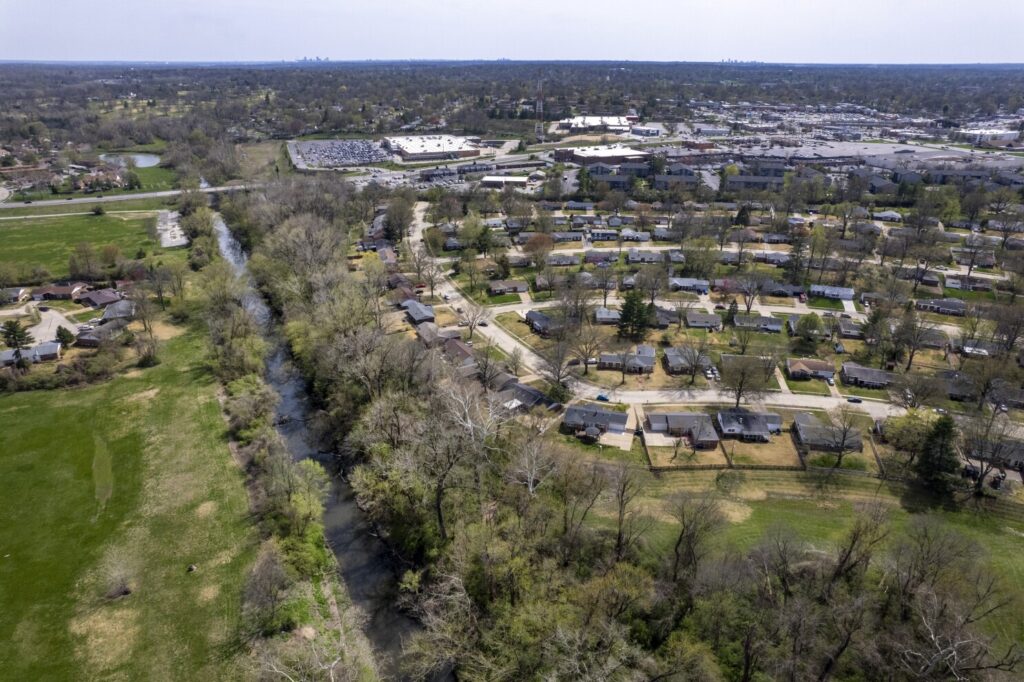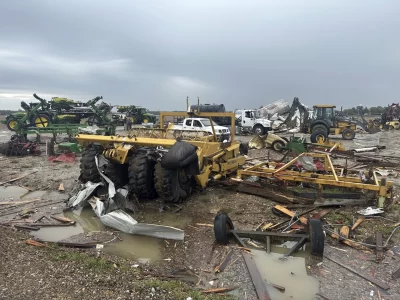
FILE - Coldwater Creek flows, April 7, 2023, in Florissant, Mo. A new report released on Tuesday, Oct. 17, by the Government Accountability Office says that future cleanup cost of 19 sites contaminated by Cold War era nuclear waste has risen $1 billion since a 2016 estimate. The sites include Coldwater Creek in suburban St. Louis, which was contaminated in the 1950s and 1960s when waste was dumped there. (AP Photo/Jeff Roberson, File)
The estimated future cost to clean up 19 sites contaminated by nuclear waste from the Cold War era has risen by nearly $1 billion in the past seven years, according to a report released Tuesday by the U.S. Government Accountability Office.
The GAO report urges the Army Corps of Engineers to improve management practices for cleaning up contaminated sites under the Formerly Utilized Sites Remedial Action Program, or FUSRAP. The recommendations include improved planning so resources can be better shared among sites and developing more comprehensive cost estimates.
Officials say inflation is partly to blame for the cost increase, along with uncertainties about the cleanup. The report found that four sites with “complicated cleanup remedies or large amounts of contamination” are responsible for about three-fourths of the cost increase. Two of those sites are in New York state — one near Niagara Falls and one in Lockport. The others are in Armstrong County, Pennsylvania, and in the St. Louis area.
The Department of Defense said they would work to implement the GAO’s recommendations, the report stated.
U.S. Rep. Jamie Raskin of Maryland, a member of the House Committee on Oversight and Accountability, noted that more than two-fifths of the sites are near low-income and minority communities.
“Decades after the federal government generated large amounts of toxic nuclear waste as a result of nuclear weapons production, America’s most underserved communities still bear the brunt of deadly contamination from one of the most significant environmental disasters in our nation’s history,” Raskin said in a statement.
The Corps of Engineers reported about $2.6 billion in future costs associated with FUSRAP, according to its fiscal year 2022 financial statement — nearly $1 billion higher than 2016 estimates. The report said yearly inflation adjustments contributed to about half of the increased cost.
Corps officials said that the rest “stems from cleanup-related uncertainties, such as sites that did not have a complete estimate in 2016 because they were still under investigation, as well as sites where the understanding of the amount and accessibility of the contamination has changed over time,” the report stated.
The report noted that FUSRAP sites vary from roughly a single acre to a site made up of 2,400 acres (971 hectares). Contamination largely consists of low levels of uranium, thorium, radium and associated decay products. The CDC’s Agency for Toxic Substances and Disease says exposure over a long period may result in anemia, cataracts and other health conditions.
But in the St. Louis area, activists have long fought for compensation for people with cancer and other serious illnesses might be connected to nuclear contamination. Uranium was processed in St. Louis starting at the onset of World War II as America raced to develop nuclear bombs, and the waste has contaminated a creek, a landfill and other properties.
In July, reporting as part of an ongoing collaboration between The Missouri Independent, the nonprofit newsroom MuckRock and The Associated Press cited thousands of pages of documents indicating decades of nonchalance and indifference about the risks posed by uranium contamination. The government documents were obtained by outside researchers through the Freedom of Information Act and shared with the news organizations.







